Postcards from the Hedge

Howdy,
Wish you were here... the weather's great. Wait, you are here, and the weather's not always great. In fact, if we wanted to really reduce our carbon footprint it might make sense to import the climate of San Francisco, where the average July temperature is 63 degrees and the January average just 14 degrees cooler. Still, there are ways to reduce our carbon footprint, our water use, and make a greener tomorrow in Charlottesville, what's supposed to be one of the greenest cities in America. Let's live the dream!
Love,
Hawes Spencer
Editor & Publisher
The Tao of Poo
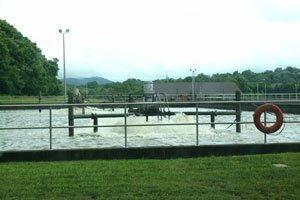
FILE PHOTO BY DAVE MCNAIR

PHOTO COURTESY WORRELL WATER TECHNOLOGIES
While the Moore's Creek Wastewater Treatment Plant undergoes a $40.3 million upgrade, one local company is taking a more natural approach to processing poo. Worrell Water Technologies, founded by former Daily Progress owner Tom Worrell, builds something called a Living Machine, a waste treatment system designed to look like a beautiful garden and mimic a tidal estuary. Essentially, the "machine" purifies wastewater without chemicals, emits no odors, all at a fraction of the price of systems like Moore's Creek. Worrell's firm has installed dozens of these system around the country, like the one shown here at the famed Esalen Institute in Northern California, but he's yet to build one in Charlottesville. "It could make a huge difference here," said Worrell. "For example, we could build a system for, say, the Belmont neighborhood for a couple million dollars, and you wouldn't even notice it was there."
Hub hubba
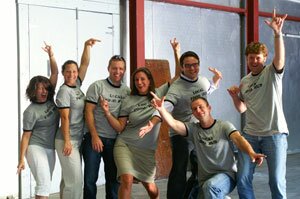
PHOTO COURTESY MARISA VROOMAN
Kate Collier (fourth from the left), founder and director of the Local Food Hub, celebrates their July 8 opening day with the Food Hub crew. Though the County Supes didn't want to support the non-profit, which now acts as a wholesale customer to local farms and a distributor of local foods to area restaurants, independent grocery stores, institutions, and even several area elementary schools, plenty of others did, including Coran Capshaw, John Grisham, the Bama Works Fund, and the Blue Moon Fund. "Projects like the Hub are popping up around the country," said the Washington Post in an August 26 story on the Hub. "And they could be the missing link between supply of and demand for products grown close to home." From left to right: Marisa Vrooman, Allison Thomas Rodriguez, Eric Gertner, Collier, Gregg Finkell, Nathan Vrooman, Alan Moore. Chofoodhub.blogspot.com. 244-3276
Landfill of the future?

FILE PHOTO BY JEN FARIELLO
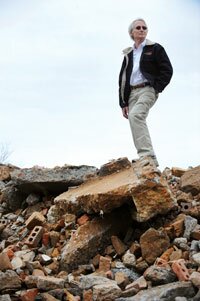
FILE PHOTO BY JEN FARIELLO
Peter Van der Linde is the biggest thorn in the side of the Rivanna Solid Waste Authority. He sued them. They sued him– complete with federal RICO claims. While the Authority's suit is getting hashed out, his $11 million Materials Recovery Facility in Zion Crossroads, which features a $3 million state-of-the-art recycling machine shown here, opened late last year and has already changed the local trash hauling business. "We've seen a tremendous increase in the number of our rural customers recycling," says Gene Ware of Time Disposal Inc., which, thanks to Van der Linde's facility, now offers curbside recycling to all its customers. "That facility has changed the picture dramatically." In about a month, Van der Linde says his facility will be able to accept household trash for recycling, an event that could divert even more of our waste away from landfills– and more money away from the struggling Rivanna Authority. Vanderlinderecycling.com. 877-981-0891
Tom's thumb

PHOTO BY DAVE MCNAIR
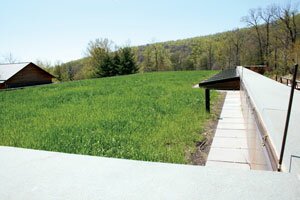
PHOTO BY DAVE MCNAIR
Monticello's new $43 million, 42,000-square-foot visitors center, which opened this spring, is not only nice to look at and wander around in; it's also a monument to sustainability. Built into the natural slope of a hillside with locally sourced materials, the complex has a geothermal heating and cooling system, two green roofs, plenty of big windows and skylights, and has systems in place to conserve water runoff and handle waste-water.
Joel Salatin
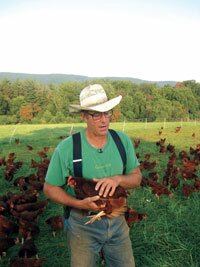
PHOTO BY DAVE MCNAIR
It's been a good year for Polyface Farms owner Joel Salatin. The self-described "Christian-libertarian-environmentalist-lunatic farmer" stars in two popular food documentaries, Food Inc. and Fresh, and just a few days ago he won a $100,000 Heinz Award for his work practicing and preaching about environmentally-friendly farming practices. "Most farmers are alot more timid than I am," says Salatin, holding one of his famous chickens as the sun rises over his Swoope, Virginia farm. "But you don't have to be a rocket scientist to understand that this is the way it should be." polyfacefarms.com
Boxing batch
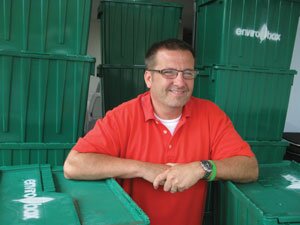
PHOTO BY HAWES SPENCER
"We were always getting calls, 'Do you have any cardboard boxes?" recalls print shop exec Ben Briggs. "That's how it started." The result at PrintSource, a locally owned print shop on Berkmar Drive, is the "EnviroBox," a green– literally– container meant to replace the once-ubiquitous cardboard box for in-town moving. For as little as $60, PrintSource will deliver 20 boxes for a weekend move– and then pick them up when it's over. "Then," says Briggs, "you don't have all those cardboard boxes to flatten and take to the landfill."
printsourceva.com 975-3000
Downtown living
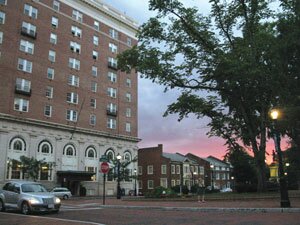
PHOTO BY HAWES SPENCER
For decades, this building– 500 Court Square– was a hotel. Following a 1980s condo conversion, it became the vanguard of more residential towers to follow: Lewis & Clark Square, Belmont Lofts, Norcross Station, Cream Street 10, and the biggest one of all, the under-construction Gleason. "Sometimes I don't fill up my gas tank in a month," says Leah Woody, whose near-downtown home on East Market Street kept her odometer from moving more than 5,000 miles last year. "I'm in the act, in the rain," she says in a 9am September 17 commuting interview– via cellphone.
Barrelling your water
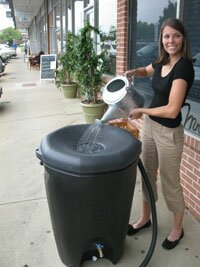
PHOTO BY HAWES SPENCER
"Why not use rainwater to water your plants? It's just kind of the smart choice." So says Paige Mattson, noting that just 1/10th inch of rainfall on a typical roof can fill her 65-gallon barrel. Having opened the Blue Ridge EcoShop in Preston Plaza two years ago, Mattson says she searched far and wide for the perfect rain barrel. While the result, dubbed "Moby" and priced at $165 isn't cheap, now that both the city and county governments are offering $30 rebates (whose forms she provides), the pain has lessened somewhat. The device also prevents green-thumbs from crushing their dreams of an organic garden with fluorinated, chlorinated, and ammonianated water. "Municipal water," notes Mattson, "isn't organic."
296-0042 blueridgeecoshop.com
Drive-by shopping
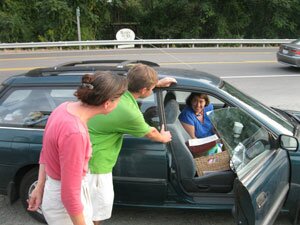
PHOTO BY HAWES SPENCER
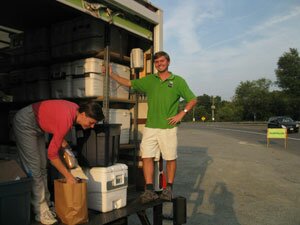
PHOTO BY HAWES SPENCER
Retail Relay is a new order-online-and-pick-up-elsewhere grocery business– sorta like Chicago's famous peapod.com "I'd be a wreck without it because I have two kids, age one and two," says Christy Lynn Flynn after Beau Brown and Annick Salomon load her car along Ivy Road on September 16. The business claims to reduce the carbon footprint because one person can shop for 20. The groceries come from such locally-owned markets as Reid's and Foods of All Nations, and– thanks to its own warehouse– Trader Joe's, a popular chain that doesn't yet have a store in Charlottesville. "This is actually fun," says Salomon, on her second day of work. retailrelay.com
The train, the train
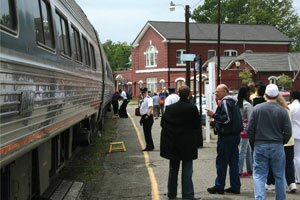
PHOTO BY HAWES SPENCER
The U.S. Transportation Department asserts that while cars devour 3,512 BTUs of energy and planes gobble 3,261, each passenger-mile in a train consumes just 2,650 BTUs, a nearly 25 percent energy savings over cars. So with the October 1 launch of a new twice-daily Amtrak service between Lynchburg and Boston, a new door opens for Charlottesvillians to enjoy the nation's most fuel-efficient major form of travel– not to mention the comfort of strolling around the cabin and getting into midtown Manhattan in only six hours. And while that may not be quite as fast as the plane, trains have been gaining ground on air travel– particularly along the traffic-choked Eastern seaboard– ever since 9/11 security snags. And it may actually boost intramodal transportation by linking Charlottesville directly to BWI, Baltimore-Washington International Airport. The new rail service comes courtesy of an annual state subsidy of nearly $3.5 million, and Meredith Richards, the former City Councilor who lobbied hard for the service, has some advice for passengers: "Use it or lose it."
amtrak.com 296-4559
The 'solar coaster' returns
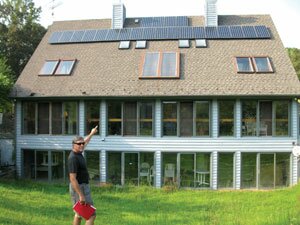
PHOTO BY HAWES SPENCER
"It's back," says Roger Voisinet, noting that solar energy systems, which had a Carter-era heyday, have recently enjoyed a rebirth due to a new wave of federal tax credits, grants, and utility buy-backs. Here, Voisinet checks out the Free Union house where he installed the pair of center panels for a thermal– i.e. hot water– solar system back in 1981. He returned in July of this year to install the 22-panel photovoltaic system near the roof peak. "It's really cool," says Voisinet, "when you see the electric meter spinning backwards."
Waterless plumbing
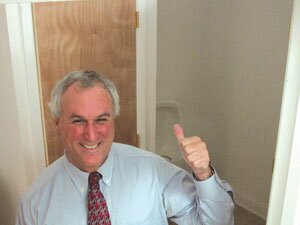
PHOTO BY HAWES SPENCER
Modern low-volume toilets with their 1.6 gallons per flush have been flushed aside by dual-flush toilets which use as little as a gallon, but in the ongoing war on water waste, a new player has arrived. "When I first got here," says Jim Principi, the new GM of the Charlottesville Radio Group, "I said what the heck is that?" The man who oversees 3WV, the Corner, WVAX, and WINA just found himself brushing up against a stakes-raising device manufactured by Sloan: the waterless urinal. It has a sealed cartridge at the base to let liquid through and keep odor out. If each man makes four visits per day, that's 1,000 flushes– or at least 1,000 gallons of water per year saved for each male employee. And you don't have to be a math whiz to appreciate that.
Stilling the waters

PHOTO BY HAWES SPENCER
Stream health experts say that velocity of water is the key culprit in degrading the aquatic life of streams. By scouring dirt off the sides, it erodes banks and swirls up life-killing sediments. UVA has helped lead the way in recent years toward fixing the problem by daylighting formerly culvertized creeks. And now that UVA is building a 50-bed long term acute care hospital, or LTACH, on Ivy Road alongside Volvo of Charlottesville, it has created this nascent stormwater and bio-retention pond– which will eventually be filled with native plants– photographed back in May. "You're not getting a bunch of mud going all over the place," says project manager Gary Lowe. "It will give time for everything to settle out properly."
Controversies in green-ville
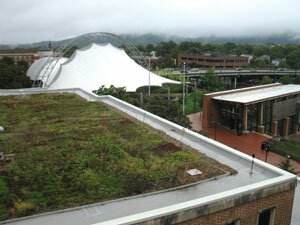
PHOTO BY HAWES SPENCER
In May 2008, the City of Charlottesville planted its "green roof," a living and breathing replacement for a 15-year-old roof it claims needed replacement anyway, so City officials like to downplay the $472,000 total project cost and focus only on the premium for adding the green systems: $59,000. Likewise, the County of Albemarle did a green roof that won a $37,000 grant from the Department of Conservation and Recreation. The County then matched an additional $38,056 for a total of $75,056– again not counting the six-figure sum to rip off and replace the old weather barriers. If they're right, then the heating and cooling savings from having such a barrier might quickly pay dividends. However, a new controversy blooms: the City and County just won a private $500,000 grant in August plus a federal stimulus grant of $255,000 to create an energy audit business of sorts. Supervisor Ken Boyd has publicly scoffed at the claim that LEAP, the Local Energy Alliance Program, which will include a revolving loan fund, can possibly create the 1,500 jobs that backers claim.
The bike commute
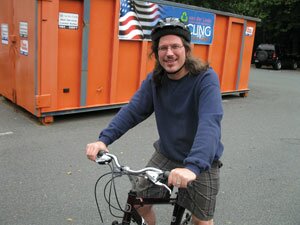
PHOTO BY HAWES SPENCER
Rob Schilling hadn't owned a bike in 30 years. But last year the iconoclastic conservative radio talk-show host got fed up with high prices and decided to reach back to his peddling roots. Now, he bikes the approximately two-mile journey from his north Charlottesville home to the AM 1070 WINA studios on Rose Hill Drive. And unlike many bikers who fight a daily battle with motor vehicles, Schilling has found a route that keeps him almost exclusively inside McIntire Park and on quiet neighborhood streets. So now he's a veritable bike-commuter. "As often as the weather allows," enthuses Schilling, photographed September 16 at ride's end. "It pumps me up for the show, and it's my main source of exercise."
The veg dude
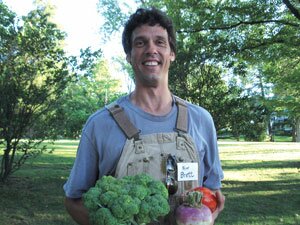
PHOTO BY HAWES SPENCER
"It's delicious," says Brett Wilson, owner/operator of the area's biggest subscription food plan. "We get the best produce within 100 miles of Charlottesville from the best local farmers and get it to good local folks." The gregarious, overall-sporting vegetable purveyor got his start in 2006 after pressing scads of apples from a doomed orchard the previous fall. Today, his Horse & Buggy Produce counts 800 subscribers gathering goods from nine drop points–- including new ones in Richmond and Lynchburg. Instead of building stores, he keeps his carbon footprint small by setting up tables in parking lots with excess capacity. But because Wilson buys his produce (from myriad organic and nearly-organic suppliers, he declines to term his service a "CSA." In the local food movement, CSA, or Community Supported Agriculture, is the big buzzword, but it also typically comes with a big buzz-kill: a work requirement for subscribers, something that's not part of Horse & Buggy. Whatever the category, customer enthusiasm can run high. "It has saved me money," says Richmond subscriber Cecelia Horner. "You get stuff that goes together. And it's absolutely super-delicious."
293-3832 horseandbuggyproduce.com (Two others in the area: bestofwhatsaround.org 286-7255 and appalachiastar.com 277-9304 )
Toilet rebates etc.

PHOTO BY HAWES SPENCER
City Hall is giving out free water-thrifty toilets, and the County is lower water rates to thrifty users! It's all part of a concerted effort to help trim consumption of the precious beverage. In fact, both the City and County will reimburse homes and businesses up to $100 each (which is all some toilets cost) for installing a low-flow toilet, such as the dual-flush model shown here at the Hook office (Al Hamraa restaurant has one too, and surely there are others around town.) As for the new rates the County enacted, they charge the wholesale water rate for a single-family dwellng's first 3,000 monthly gallons. That's below the County's actual cost, but from there the price begins spiking: to 2x wholesale for the next 3,000 gallons, 3x wholesale for the next 3,000, and a top rate of 4x wholesale for all use over 9,000 gallons. The City of Charlottesville hasn't yet followed suit, but even before the County took this bold action July 1, water consumption across both jurisdictions had already fallen 22 percent over the past decade.
Dry cleaning greenies
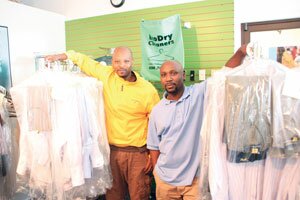
PHOTO BY DAVE MCNAIR
Ty Cooper and Quinton Harrell opened EcoDry Cleaners on West Main Street last May. Harrell has the business in his genes, as he says his late grandmother was in dry-cleaning for 30 years. But as Cooper points out, they didn't want to work around the harsh chemicals that are used at most traditional dry-cleaners. Instead, their special machines use CO2 to clean your clothes, what they call the "green way to dry clean."
Out to pasture
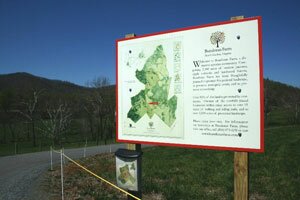
FILE PHOTO BY DAVE MCNAIR
Since 2005, when the 2,300-acre Bundoran Farm on 29 South was purchased (for a whopping $33 million) by Qroe Farm Preservation Development, the developers have sought to make it a model of rural land stewardship. For example, rather than cutting it up into 21-acre lots as County ordinances allow, over 90 percent of the land will remain untouched. This includes 1,000 acres of pasture for livestock, 200 acres of apple orchards, 1,000 acres of managed forest, fifteen miles of walking and riding trails, and two ponds. The plan is to send the money paid by land-leasing farmers to the homeowners' association, which will in turn safeguard the land for farming. Bundoran's development director Joe Barnes says the vision is three-fold: to preserve agricultural land, enable on-going environmental stewardship, and allow folks to live on a farm without the headache of having to manage one.
Reuse for Moon-Henderson
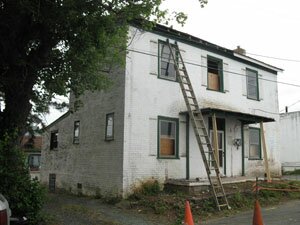
FILE PHOTO BY HAWES SPENCER
In June, ex-scrap yard owner and Board of Architectural Review member Preston Coiner purchased the Moon-Henderson House, a circa-1883 structure at 10 1/2 Street NW, and one of the few remnants of a once thriving African-American neighborhood along West Main. Former owner Bill Chapman had wanted to demolish the building last year, but the BAR denied the request. Unlike Chapman, the former BAR member thought he could restore the property. But, as Chapman pointed out, won't it be expensive? "It might be," Coiner laughs. "I'm very happy that the property was sold to someone who is protecting and rehabilitating the building," said City Preservation Planner Mary Joy Scala. "Preston is a real hero."
#
1 comment
interesting what you got goin on here. could you share a few pointers maybe? im sturggling to get my blog even off the ground. you have my email if you don't want to post it here for everyone to see